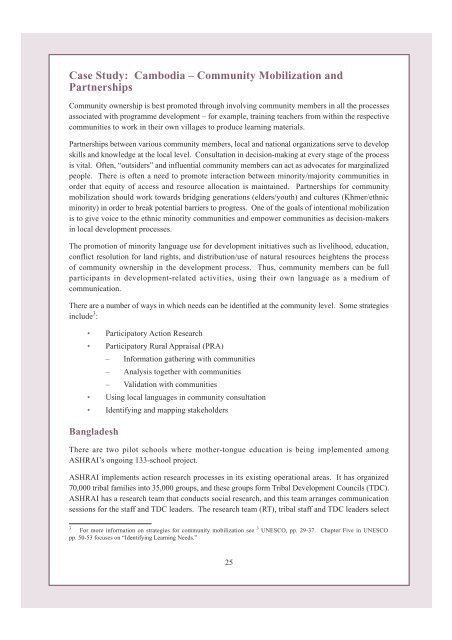Part I.pdf - MTB-MLE Network
Part I.pdf - MTB-MLE Network
Part I.pdf - MTB-MLE Network
Create successful ePaper yourself
Turn your PDF publications into a flip-book with our unique Google optimized e-Paper software.
Case Study: Cambodia – Community Mobilization and<strong>Part</strong>nershipsCommunity ownership is best promoted through involving community members in all the processesassociated with programme development – for example, training teachers from within the respectivecommunities to work in their own villages to produce learning materials.<strong>Part</strong>nerships between various community members, local and national organizations serve to developskills and knowledge at the local level. Consultation in decision-making at every stage of the processis vital. Often, “outsiders” and influential community members can act as advocates for marginalizedpeople. There is often a need to promote interaction between minority/majority communities inorder that equity of access and resource allocation is maintained. <strong>Part</strong>nerships for communitymobilization should work towards bridging generations (elders/youth) and cultures (Khmer/ethnicminority) in order to break potential barriers to progress. One of the goals of intentional mobilizationis to give voice to the ethnic minority communities and empower communities as decision-makersin local development processes.The promotion of minority language use for development initiatives such as livelihood, education,conflict resolution for land rights, and distribution/use of natural resources heightens the processof community ownership in the development process. Thus, community members can be fullparticipants in development-related activities, using their own language as a medium ofcommunication.There are a number of ways in which needs can be identified at the community level. Some strategiesinclude 3 :• <strong>Part</strong>icipatory Action Research• <strong>Part</strong>icipatory Rural Appraisal (PRA)– Information gathering with communities– Analysis together with communities– Validation with communities• Using local languages in community consultation• Identifying and mapping stakeholdersBangladeshThere are two pilot schools where mother-tongue education is being implemented amongASHRAI’s ongoing 133-school project.ASHRAI implements action research processes in its existing operational areas. It has organized70,000 tribal families into 35,000 groups, and these groups form Tribal Development Councils (TDC).ASHRAI has a research team that conducts social research, and this team arranges communicationsessions for the staff and TDC leaders. The research team (RT), tribal staff and TDC leaders select3For more information on strategies for community mobilization see 3 UNESCO, pp. 29-37. Chapter Five in UNESCOpp. 50-53 focuses on “Identifying Learning Needs.”25
















